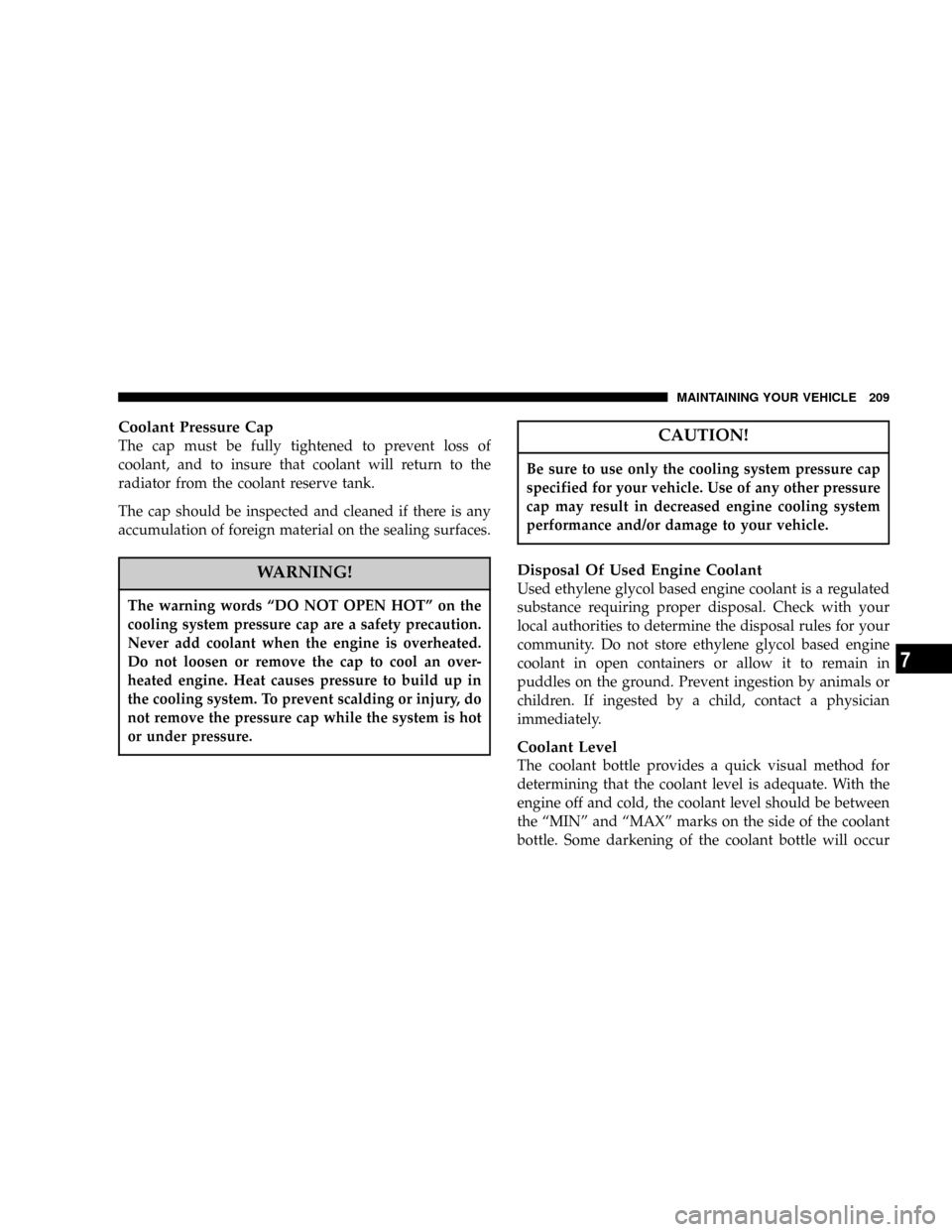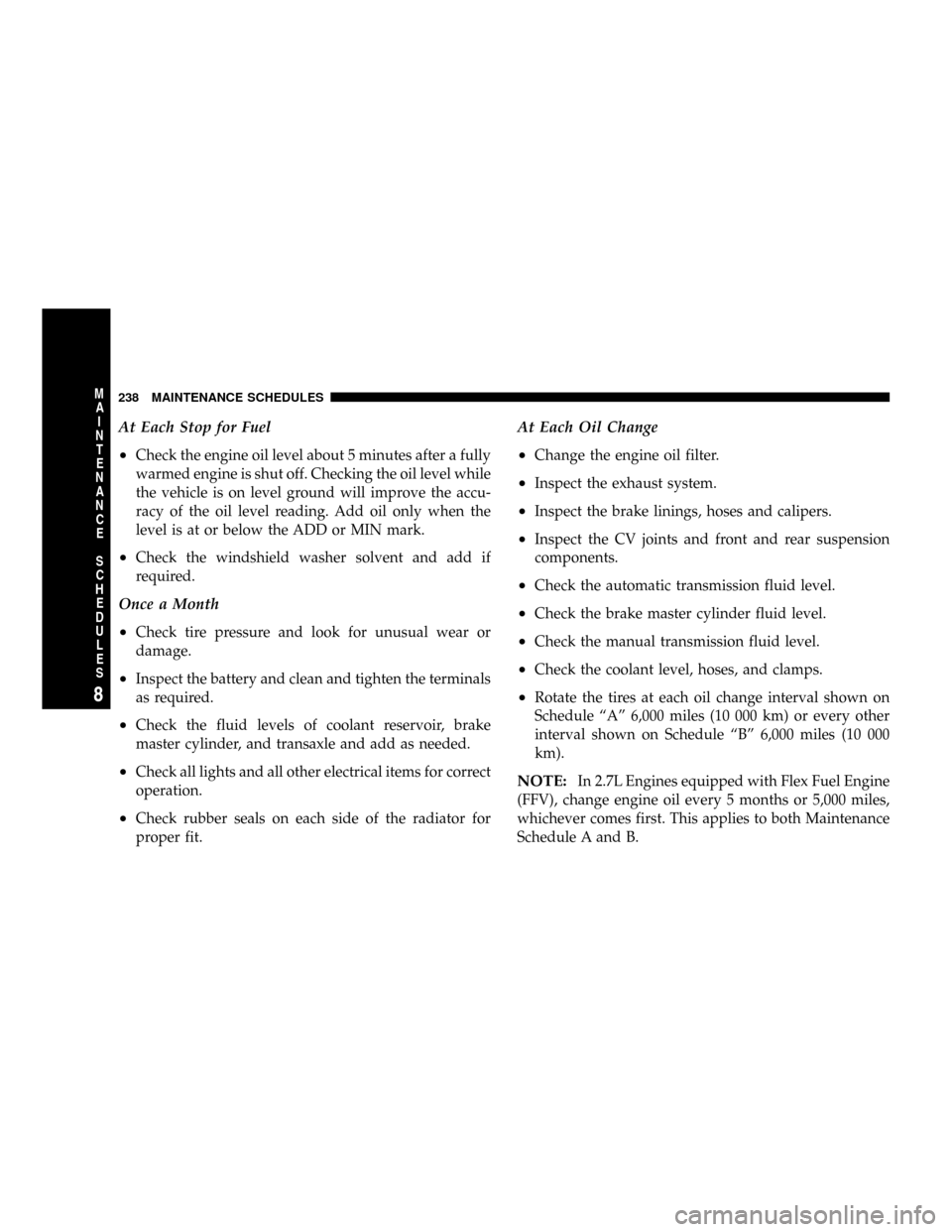coolant level CHRYSLER SEBRING CONVERTIBLE 2004 2.G Owners Manual
[x] Cancel search | Manufacturer: CHRYSLER, Model Year: 2004, Model line: SEBRING CONVERTIBLE, Model: CHRYSLER SEBRING CONVERTIBLE 2004 2.GPages: 271, PDF Size: 5.31 MB
Page 125 of 271

NOTE:The defroster turns off automatically after 15
minutes of operation. Each later activation will allow 10
minutes of operation.
Side Window Demisters
A side window demister outlet is at each end of the
instrument panel. These non-adjustable outlets direct air
toward the side windows when the system is in either the
FLOOR, MIX, or DEFROST modes. A small amount of air
is directed to the side window demisters in BI-LEVEL
mode as well. The air is directed at the area of the
windows through which you view the outside mirrors.
Windshield and Side Window Fogging
Interior fogging on the windshield can be quickly
removed by using the defrost position on the mode
control.
Your side windows may fog on the inside in mild
rainy or humid weather. To clear the windows,
select the Panel-Air Conditioning mode on the
Mode Control. Point the panel outlets toward the side
windows.
NOTE:Do not use the recirculation mode as it will not
clear windows under these conditions.
Summer Operation
Air conditioned vehicles must be protected with a high-
quality antifreeze coolant to provide proper corrosion
protection and to raise the boiling point of the coolant for
protection against overheating. A 50 % concentration is
recommended.
Winter Operation
The blower air will heat faster in cold weather if you use
only the low blower speeds for the first 10 minutes of
operation. During engine warm up in cold weather, use
the Defrost mode to direct any cold air away from vehicle
occupants. Use of the Recirculate-Air Conditioning Mode
during winter months is not recommended due to the
possibility of window fogging.
NOTE:See Operating Tips chart (for Manual A/C
Control) at the end of this section for suggested control
settings in different weather conditions.
UNDERSTANDING YOUR INSTRUMENT PANEL 125
4
Page 208 of 271

Cooling System Ð Drain, Flush and Refill
At the intervals shown on the Maintenance Schedules,
the system should be drained, flushed and refilled. The
first change should not be required until 5 years or
100,000 miles (160,000 km), whichever comes first. The
coolant should be flushed and changed every two years
or 36,000 miles (57,600 km) thereafter.
If the solution is dirty and contains a considerable
amount of sediment, clean and flush with a reliable
cooling system cleaner. Follow with a thorough rinsing to
remove all deposits and chemicals. Used automotive
antifreeze is a recyclable commodity. Discard or recycle
as facilities exist in your area.
Selection Of Coolant
Use only the manufacturer's recommended coolant, refer
to Recommended Fluids, Lubricants and Genuine Parts
for correct coolant type.
CAUTION!
Failure to use the proper antifreeze could cause
radiator plugging and engine overheating. Do not
mix antifreeze brands or use plain water alone or
alcohol base antifreeze products. Do not use addi-
tional rust inhibitors or antirust products, as they
may not be compatible with the radiator coolant and
may plug the radiator or heater core.
Adding Coolant
When adding coolant, a solution of 50% ethylene glycol
antifreeze coolant in distilled water should be used. Use
higher concentrations (not to exceed 60%) if temperatures
below -32ÉF (-35ÉC) are anticipated.
Please note that it is the owner's responsibility to main-
tain the proper level of protection against freezing ac-
cording to the temperatures occurring in the area where
the vehicle is operated.
208 MAINTAINING YOUR VEHICLE
Page 209 of 271

Coolant Pressure Cap
The cap must be fully tightened to prevent loss of
coolant, and to insure that coolant will return to the
radiator from the coolant reserve tank.
The cap should be inspected and cleaned if there is any
accumulation of foreign material on the sealing surfaces.
WARNING!
The warning words ªDO NOT OPEN HOTº on the
cooling system pressure cap are a safety precaution.
Never add coolant when the engine is overheated.
Do not loosen or remove the cap to cool an over-
heated engine. Heat causes pressure to build up in
the cooling system. To prevent scalding or injury, do
not remove the pressure cap while the system is hot
or under pressure.
CAUTION!
Be sure to use only the cooling system pressure cap
specified for your vehicle. Use of any other pressure
cap may result in decreased engine cooling system
performance and/or damage to your vehicle.
Disposal Of Used Engine Coolant
Used ethylene glycol based engine coolant is a regulated
substance requiring proper disposal. Check with your
local authorities to determine the disposal rules for your
community. Do not store ethylene glycol based engine
coolant in open containers or allow it to remain in
puddles on the ground. Prevent ingestion by animals or
children. If ingested by a child, contact a physician
immediately.
Coolant Level
The coolant bottle provides a quick visual method for
determining that the coolant level is adequate. With the
engine off and cold, the coolant level should be between
the ªMINº and ªMAXº marks on the side of the coolant
bottle. Some darkening of the coolant bottle will occur
MAINTAINING YOUR VEHICLE 209
7
Page 210 of 271

over time. This is normal. If the coolant level is hard to
see, jostling the coolant bottle will make it easier to see.
There is no need to remove the radiator cap unless
checking for coolant freeze point, adding, or replacing
coolant. Advise your service attendant of this. As long as
the engine operating temperature is satisfactory, the
coolant bottle need only be checked once a month. Heater
performance may also be adversely affected by low
coolant levels.
When additional coolant is needed to maintain the
proper level, it should be added to the coolant bottle. Do
not overfill. Special procedures are required when filling
the engine cooling system of the 2.7L Engine. See your
authorized dealer for details.
Points to Remember
NOTE:
When the vehicle is stopped after a few miles of
operation, you may observe vapor coming from the front
of the engine compartment. This is normally a result of
moisture from rain, snow, or high humidity accumulating
on the radiator and being vaporized when the thermostat
opens, allowing hot water to enter the radiator.
If an examination of your engine compartment shows no
evidence of radiator or hose leaks, the vehicle may be
safely driven. The vapor will soon dissipate.
²Do not overfill the coolant bottle.
²Check coolant freeze point in the system.
²If frequent coolant additions are required, or if the
level in the bottle does not drop when the engine cools,
the cooling system should be pressure tested for leaks.
²Maintain coolant concentration of 50% ethylene glycol
(minimum) with recommended antifreeze for proper
corrosion protection of your engine that contains alu-
minum components.
²Make sure that the radiator and coolant bottle hoses
are not kinked or obstructed.
²Keep the front of the radiator clean. If your vehicle has
air conditioning, keep the front of the condenser clean,
also.
²Do not change the thermostat for summer or winter
operation. If replacement is ever necessary, install
210 MAINTAINING YOUR VEHICLE
Page 238 of 271

At Each Stop for Fuel
²
Check the engine oil level about 5 minutes after a fully
warmed engine is shut off. Checking the oil level while
the vehicle is on level ground will improve the accu-
racy of the oil level reading. Add oil only when the
level is at or below the ADD or MIN mark.
²Check the windshield washer solvent and add if
required.
Once a Month
²
Check tire pressure and look for unusual wear or
damage.
²Inspect the battery and clean and tighten the terminals
as required.
²Check the fluid levels of coolant reservoir, brake
master cylinder, and transaxle and add as needed.
²Check all lights and all other electrical items for correct
operation.
²Check rubber seals on each side of the radiator for
proper fit.
At Each Oil Change
²
Change the engine oil filter.
²Inspect the exhaust system.
²Inspect the brake linings, hoses and calipers.
²Inspect the CV joints and front and rear suspension
components.
²Check the automatic transmission fluid level.
²Check the brake master cylinder fluid level.
²Check the manual transmission fluid level.
²Check the coolant level, hoses, and clamps.
²Rotate the tires at each oil change interval shown on
Schedule ªAº 6,000 miles (10 000 km) or every other
interval shown on Schedule ªBº 6,000 miles (10 000
km).
NOTE:In 2.7L Engines equipped with Flex Fuel Engine
(FFV), change engine oil every 5 months or 5,000 miles,
whichever comes first. This applies to both Maintenance
Schedule A and B.
238 MAINTENANCE SCHEDULES
8
M
A
I
N
T
E
N
A
N
C
E
S
C
H
E
D
U
L
E
S
Page 260 of 271

About Your Brakes...................... 142
Adding Engine Coolant (Antifreeze)......... 208
Adding Fuel.......................... 164
Aiming Headlights...................... 232
Air Cleaner, Engine..................... 198
Air Conditioning....................... 122
Air Conditioning, Operating Tips........... 126
Air Conditioning Refrigerant.............. 202
Air Conditioning System..............122,201
Air Pressure, Tires...................... 153
Airbag................................ 29
Airbag Deployment...................... 32
Airbag Light.....................32,34,43,87
Airbag Maintenance...................... 34
Alarm, Panic........................... 17
Alarm System........................19,92
Alignment and Balance.................. 158
Alterations/Modifications, Vehicle............ 6
Antifreeze Disposal..................... 209
Antifreeze (Engine Coolant)............... 208
Capacities........................... 232
Anti-Lock Brake System.................. 142
Anti-Lock Warning Light.................. 90Anti-Theft Security Alarm................. 19
Appearance Care....................... 216
Automatic Dimming Mirror................ 56
Automatic Door Locks.................... 14
Automatic Transaxle...............135,186,213
Filter.............................. 215
Fluid and Filter Changes................ 215
Fluid Level Check..................... 214
Interlock System....................10,136
Reset Mode......................... 137
Selection Of Lubricant................. 214
Shifting............................ 137
Special Additives..................... 215
Autostick............................. 160
Auxiliary Power Outlet................... 78
Ball Joints............................ 203
Battery............................... 200
Emergency Starting.................... 181
Gas Caution......................183,201
Heater............................. 134
Jump Starting........................ 181
Keyless Transmitter Replacement.......... 18
260 INDEX
Page 262 of 271

Compact Disc Player..................97,102
Compact Spare Tire..................... 155
Compass.............................. 92
Compass Calibration..................... 94
Console............................... 55
Contract, Service....................... 254
Convertible............................ 47
Convertible Boot........................ 50
Convertible Top......................... 47
Convertible Top Maintenance.............. 221
Cooling System........................ 207
Adding Coolant (Antifreeze)............. 208
Coolant Capacity..................... 232
Coolant Level........................ 209
Disposal of Used Coolant............... 209
Drain, Flush, and Refill................. 208
Inspection........................... 207
Points to Remember................... 210
Pressure Cap........................ 209
Radiator Cap........................ 209
Rubber and Plastic Components.......... 211
Selection of Coolant................... 208
Corrosion Protection.................... 216Crankcase Emission Control System......... 200
Cruise Control.......................... 70
Cruise Light........................... 87
Customer Assistance.................... 252
Daytime Running Lights.................. 66
Dealer Service......................... 193
Defroster, Rear Window.................. 124
Defroster, Windshield..................43,124
Diagnostic System, Onboard............... 191
Dimmer Control........................ 65
Dimmer Switch, Headlight................. 67
Dipsticks
Automatic Transaxle................... 214
Disposal
Antifreeze........................... 209
Engine Oil.......................... 197
Door Ajar Warning...................... 14
Door Locks............................ 12
Door Locks, Automatic................... 14
Door Opener, Garage..................... 73
Drive Belts............................ 198
262 INDEX